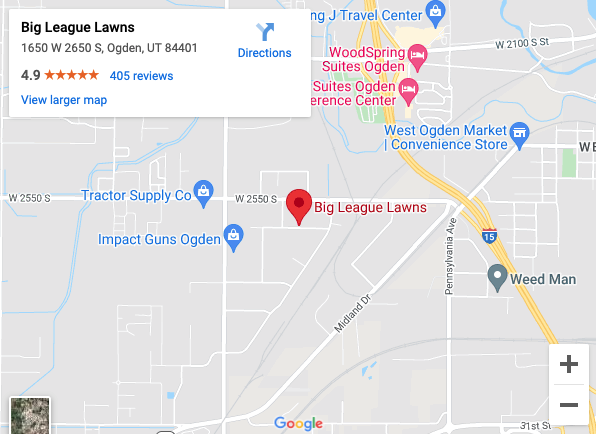Why does my grass look tired in the summer, even though I water it regularly? We hear this question frequently, and it’s a good one. The lawn needs a change from season to season, and what worked for the grass in spring might leave it starving for water in the summer – what we call a “drought-stressed lawn.” You’ll see it in the brown grass that’s greener in the shade and lack of bounce-back when you walk on your lawn. It’s not hard to fix and common in Utah.
If your lawn is suffering from drought stress, here are some things to keep in mind to get your lawn looking great again.
Call Now!



Water Comes in Through the Roots
Remember, plants drink from their roots, and your goal in watering is to provide refreshment where they can use it. As the weather gets hotter, light watering evaporates before it sinks into the soil, and the grassroots could stay dry. Lawns adapt by going dormant, turning brown, and waiting for the drought to pass. It’s hard to tell the difference between dormant and dying without testing, though.
The good news is that drought stress in your lawn is not a permanent condition. Those brown patches of grass that can show up during the hotter part of the summer are a protective mechanism that many plants, including lawn grasses, will activate when they’re not getting enough water. There are several ways to deal with lawn drought, but first, you must identify the problem.
Summer is just around the corner, and your lawn is in for a tough time!
With the scorching heat and drought conditions, your lawn is going to need some extra TLC. But don’t sweat it, we’ve got the solution to keep your lawn cool, green and healthy all season long.
That’s where our Spring Soil Conditioner Service comes in! Think of it as a refreshing drink of water for your lawn. Helping it to:
- Retain up to 20% more water, even in the driest of conditions.
- Breathe easier without messy aeration plugs & broken sprinklers.
- Get the maximum benefits from your regular treatments.
Don’t let your lawn suffer this summer. Treat it to a day at the spa with our Soil Conditioner Service.
Soil conditioners can help to:- Increase water retention in the soil, which helps your lawn stay hydrated during drought conditions.
- Improve soil aeration, allowing roots to breathe and grow more effectively.
- Increase the availability of nutrients in the soil, helping your lawn to grow thicker and healthier.
- Reduce soil compaction, which can improve water penetration and root growth.
- Improve soil structure and texture, which can enhance the overall health of your lawn.
All of these benefits can lead to a greener, healthier lawn that is better equipped to handle the challenges of the hot summer months.
Contact us today to schedule your service and give your lawn the love it deserves.
The Grub Question
Grub infestations can look a lot like a dry lawn but the roots are not just dry, they’re being eaten by the grubs. We can inspect for grubs and perform preventive and corrective grub treatments.
Changing Your Watering Strategy
From spring to summer, it’s important to change how you water so that grass plants drink deeply in hot, dry weather. Rather than just wetting the lawn, you need to make sure that the soil is soaking up the water and holding it for the grass. Watering is more effective between evening and early morning when the sun isn’t pulling water right into the air from the surface.
Eliminate Drought-Stressed Lawns in Utah
We’re glad to give you some spring training and get you ready to water effectively during the summer months. Here’s our local guide to watering which will get you started – give us a call for personalized, expert lawn help in Davis County and Weber County, Utah.
What to Do About Lawn Drought Stress?
- Check and clean your sprinkler filter heads. A clogged filter head can prevent your sprinkler system from watering the whole lawn surface. Most sprinkler systems have a simple mechanism that can be disassembled with a screwdriver or a pair of needle-nosed pliers. Cleaning the filters out or replacing them can bring your lawn back to life.
- Water the lawn sufficiently for your type of grass. A lot of people try to keep their lawns green and their water bills down by running the sprinklers frequently, but with less water. Hello, drought stress! Deeper watering to reach the root structures works better. Cool seasonal grasses need at least an inch of water per week, for example, split over two half-inch watering sessions.
- Raise your lawnmower blade. The root structure for any plant is usually proportional to the height of the plant. Raising your lawn mower blade to a height of at least 3 inches will allow the grass to grow a little bit taller, and the roots will reach that much deeper. This allows the roots to reach more water and helps prevent drought stress.
- Call Big League Lawns. We have more than 40 years of experience in lawn care, serving Weber and Davis counties in Utah. We’ll provide you with a free lawn analysis if you call us at 801-917-6572.
Drought Stress Vs. Drought Damage
Summers in Utah are hot and dry. That combination of tough seasonal weather elements can inflict severe drought stress and even drought damage to a previously thriving lawn. You may assume that after the cooler temperatures return and rain begins to fall more frequently, your lawn should bounce back to its former beautiful, healthy condition, but it’s not quite that predictable.
Drought stress is one thing. It might be just temporary. However, drought damage is a different problem, and it can be expected to be more difficult to correct. So, what’s the difference between the two Utah summertime grass care problems?
Drought Stress Lawn
Drought stress happens when a grass type that flourishes in the warm season, for example, Bermuda grass, is growing but is not getting the necessary amount of water to thrive. As a mode of self-preservation, the grass reacts by entering into a state of dormancy triggered by the drought-like environment. Symptoms of drought stress can include thinning grass and loss of healthy green color.
Drought Damage Lawn
Drought Damage is the advanced set of effects of drought stress. The grasses that typically grow well in warm weather utilize the process of photosynthesis to generate and store carbohydrates. When drought-like conditions of extreme heat and lack of adequate moisture persist, the process is disrupted, causing the grass to have insufficient nutrition and hydration. The consequences are thinner turf grass and slower than normal growth into a robust green lawn during the spring.
Stages of Drought Stress Leading to Drought Damage
These are stages of drought stress in plants. The several stages of decline from drought stress in grass mark the process leading to drought damage on a lawn:
Early Signs of Drought Stress Appear on Grass
During this first phase of drought stressing your grass, large areas or the entire lawn may start to appear grayish. When you walk across the lawn, you may leave footprints in the weak ailing turf grass. That’s a sure sign of a severely dehydrated lawn. It’s crucial during this phase to water regularly to rehydrate the grass and help it hopefully rebound within a couple of days or so.
Final Phase of Stress Prior to Damage
This is the last chance. It’s the final phase in which there’s a good chance that routine watering may revitalize your grass, just before the point that growth ceases. Growth is slowing at this stage, and patches caused by imbalanced moisture reserves in the soil may appear. Grass blades begin to collapse. Routine watering may still revive the grass within 4 to 5 days.
Pre-Dormant State
In this phase of drought stress, the grass begins to conserve its scarce resources. The lawn begins to look slightly less green and more brownish. Mowing can badly damage the lawn during this phase. The best approach to attempt restoration of the grass is heavy watering daily for a few days. With consistently ample watering, the grass may ultimately recover within about 10 days to 2 weeks.
Dormant State
This is the desperate near-death stage of severely drought-stressed grass. The lawn is entirely brown at this point. Grass blades become narrower, although the crowns and roots are still alive. Diligent deep routine watering for 2 to 3 weeks is the best approach to salvaging the lawn. However, if some areas of the lawn have nutrient-depleted soil, the grass in those sections may not be recoverable.
For Revitalization of a Drought Stressed Lawn
It may be too difficult to revive a drought-stressed lawn before damage occurs without help from a lawn rehabilitation expert. Big League Lawns grass recovery specialists can identify specific issues in your particular lawn and provide the precisely needed treatment to revitalize your grass.


